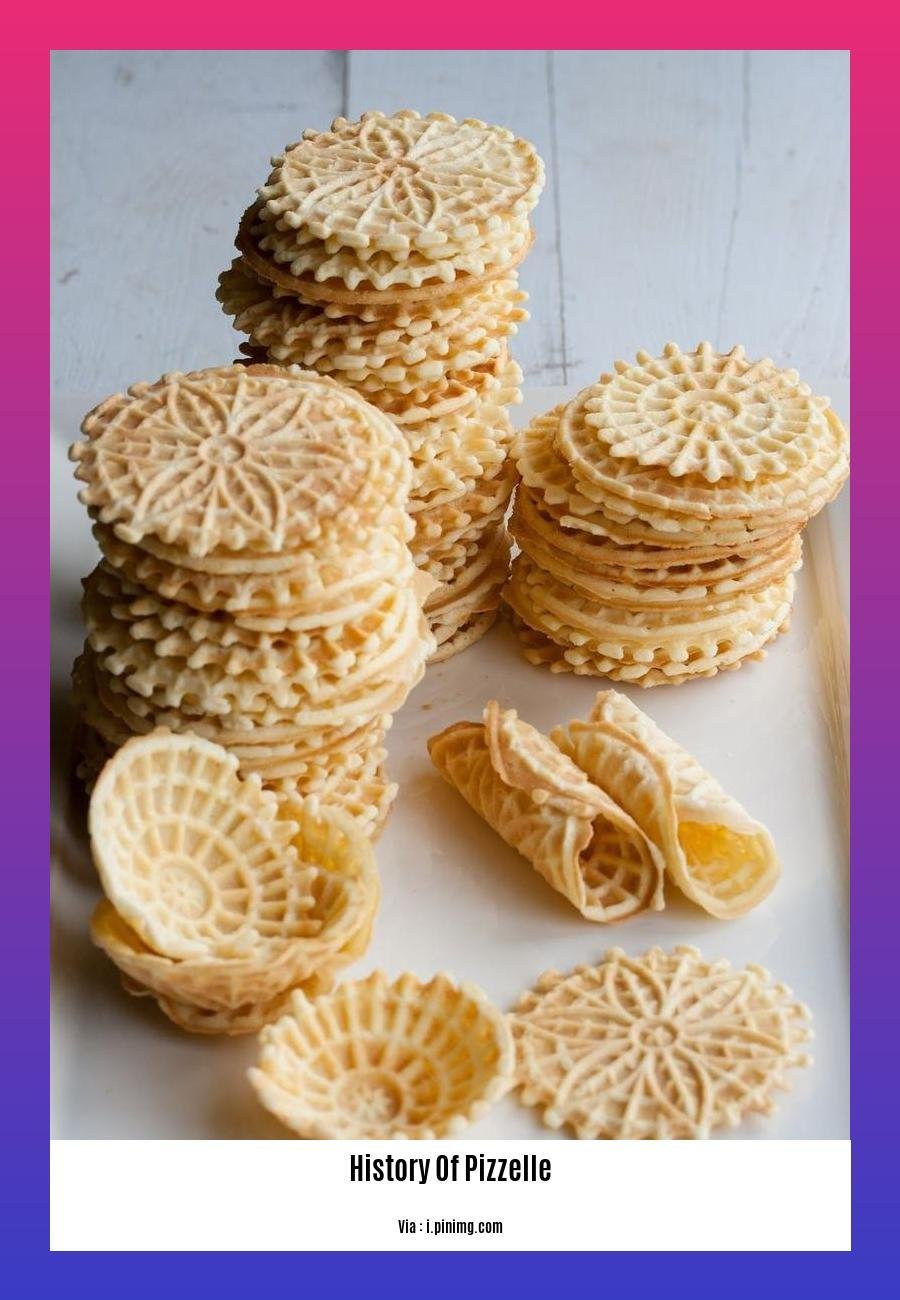– Unveiling the History of Pizzelle: A Culinary Journey Through Time- Dive into the delectable history of the pizzelle, an Italian cookie that has tantalized taste buds for centuries. Join us on an enchanting voyage through time to uncover the origins and evolution of this beloved treat, from its humble medieval beginnings to its cherished presence at modern-day celebrations.
Key Takeaways:
- Pizzelle is an early Italian cookie that may have originated from the Roman crustulum.
- Its name, “pizzelle,” means “round and flat.”
- The cookie has been adopted by other cultures, like the Norwegian Krumkake.
- Pizzelles are believed to have originated in south-central Italy in the 8th century.
- In the Italian village of Colcullo, pizzelles were historically served at the “Festival of the Snakes” to commemorate the town’s deliverance from a snake infestation.
History of Pizzelle

Food has been evolving for centuries, and I’m here to talk about the history of pizzelle. Let’s jump right in!
Pizzelle is an irresistible Italian cookie with a rich background. Its origins can be traced back to medieval times, with some scholars believing it descends from the Roman crustulum.
Fun Fact: Pizzelle’s round and flat shape is reflected in its name, which derives from the Italian word “pizze” (meaning the same).
This delectable treat became popular in south-central Italy around the 8th century. By the 16th century, it had spread throughout the country.
But wait, there’s more! Pizzelle even crossed cultural boundaries. It found a home in Norway as the “Krumkake.”
In the Italian village of Colcullo, pizzelles played a special role in the “Festival of the Snakes.” They were believed to bring good luck and commemorate the town’s escape from a snake infestation.
Here’s a Timeline of Pizzelle’s Journey:
- 8th Century: Origins in south-central Italy
- 16th Century: Popularity throughout Italy
- 19th Century: Emigration to America with Italian immigrants
Today, pizzelles remain a cherished part of Italian heritage and celebrations. They’re a delightful addition to any cookie platter or a sweet treat to savor.
Uncover the fascinating origins of these delectable treats by delving into the History Of Pizzelles, a journey that will transport you to the enchanting culinary traditions of Italy. Explore the rich heritage of the beloved History Of Italian Pizzelle Cookies, where you’ll discover the secrets behind their intricate designs and alluring flavors. And for those seeking an in-depth understanding, embark on a journey through Pizzelle Cookies History, where the evolution of these irresistible treats is meticulously unveiled.
History of Italian Pizzelle Cookies

Prepare to embark on a captivating culinary expedition into the origins of the delectable pizzelle cookie, an Italian culinary masterpiece that has tantalized taste buds for centuries.
Ancient Culinary Roots
The pizzelle’s lineage stretches back to ancient times, possibly as far back as the 8th century. Some scholars speculate that it evolved from the Roman “crustulum,” a flatbread-like treat. Its name, “pizzelle,” derives from the Italian word “pizze,” meaning “round and flat.”
Religious Significance
Pizzelle played a significant role in religious celebrations, particularly the “Festival of the Snakes” in the Italian village of Colcullo. According to legend, pizzelle were offered as a gesture of gratitude for deliverance from a snake infestation.
Symbol of Celebration
Throughout history, pizzelle became synonymous with joyous occasions, such as weddings and festivals. Its delicate texture and intricate designs made it a perfect symbol of celebration and merriment.
Culinary Evolution
Over time, pizzelle recipes evolved, incorporating regional variations and diverse flavors. Traditional ingredients include flour, eggs, sugar, butter or oil, and a hint of anise or vanilla. The distinctive imprinted design is created using a specialized waffle iron called a “ferraiolo.”
Key Takeaways:
- The history of Italian pizzelle cookies dates back to ancient times.
- Pizzelle played a role in religious festivals and were a symbol of celebration.
- The recipe and design of pizzelle have evolved over time, incorporating regional flavors and variations.
Relevant URL Sources:
- Pizzelle: Traditional Biscuit With a Long History
- The Possible 8th Century Origins Of Pizzelle Cookies
History Of Pizzelle In The World
Step back in time with me as we embark on a culinary adventure to uncover the intriguing history of pizzelle, a beloved cookie that has graced tables for centuries.
Key Takeaways:
- Ancient Origins: Pizzelle’s roots can be traced back to the 8th century in Italy’s south-central region.
- Religious Significance: In the town of Colcullo, pizzelle played a sacred role in the “Festival of the Snakes,” symbolizing deliverance from a snake infestation.
- Evolution of Traditions: Over time, pizzelle evolved into a symbol of celebration and joy, with regional variations in recipes and designs.
- Unique Design: The iconic imprinted design on pizzelle is created using a specialized waffle iron called a “ferraiolo.”
The Pizzelle’s Journey Through Time
The pizzelle’s journey began in medieval kitchens, where it was crafted from simple ingredients like flour, eggs, sugar, and butter or oil. Anise or vanilla added a touch of sweetness and aroma.
As centuries passed, pizzelle became a staple in Italian households, served at festive gatherings and religious holidays. It crossed borders, finding its way into other cultures, such as the Norwegian Krumkake.
Today, pizzelle continues to delight taste buds worldwide, whether enjoyed as a standalone treat or adorned with powdered sugar or sweet fillings.
References:
FAQ
Q1: What is the origin of pizzelle cookies?
A1: Pizzelle cookies originated in Italy, possibly as early as the 8th century.
Q2: What is the significance of pizzelle cookies?
A2: Pizzelle cookies hold cultural significance in Italy, being associated with weddings, religious festivals, and Christmas celebrations.
Q3: How are pizzelle cookies traditionally made?
A3: Traditionally, pizzelle cookies are made using a special pizzelle iron, which creates their distinctive thin, crispy texture and imprinted design.
Q4: Are pizzelle cookies popular outside of Italy?
A4: Yes, pizzelle cookies have spread beyond Italy and are enjoyed in various countries, including the United States, where they are often associated with Italian-American heritage.
Q5: What are the variations of pizzelle cookies?
A5: Pizzelle cookies can vary in flavor and appearance, with common variations including vanilla, almond, chocolate, and anisette.
- Unveiling Bernhard Caesar Einstein’s Scientific Achievements: A Legacy in Engineering - July 15, 2025
- Uncover who is Jerry McSorley: CEO, Family Man, Business Success Story - July 15, 2025
- Discover Bernhard Caesar Einstein’s Scientific Contributions: Unveiling a Legacy Beyond Einstein - July 15, 2025















